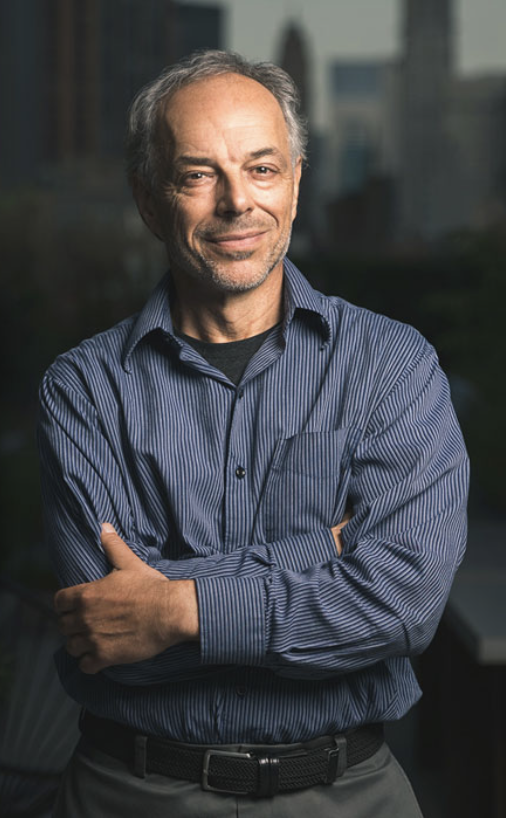11. The Inner Lives and Cultural Worlds of Animals – with Carl Safina
“You can't just lose an animal culture in a region and expect that throwing a few animals there will get them back, because it doesn't always work. they're basically being abandoned in the hope that they'll know what to do.”
- Carl Safina
SYNOPSIS:
Carl Safina is an ecologist, author, conservationist, and animal translator whose body of work probes how free-living animals experience life. His books Beyond Words: What Animals Think and Feel and Becoming Wild: How Animal Cultures Raise Families, Create Beauty, and Achieve Peace have won numerous awards. Audubon named Carl Safina among its “100 Notable Conservationists of the 20th Century.”
Carl uncovers the rich truth that many species and animals have entire cultures, traditions, familial stories, and individual quests, that all are part of this symbiotic tapestry of tales that we call “nature”. He travels alongside the sweeping wingspans of albatrosses, the elephants of East Africa, the wolves of Yellowstone, the Orcas of the Pacific Northwest, sperm whales, seals, turtles, deciphering the role of matriarchs and elders, describing how individual personalities affect all kinds of behaviors, and how these creatures too experience mourning, loss, and grief.
Here we speak about all these interlocking animal worlds and lives, their highly evolved and complex cultural systems, how the world is awash in waves of communication, the imperfect evolutionary work in progress known as human empathy, and how knowledge of their existence should drastically influence strategies of conservation and regeneration. We end on a profound note speaking to the role of beauty across species and minds.
“Culture is Life itself adjusting and responding and expressing to the corner of this galaxy in which it finds itself” - Carl Safina
GUEST BIO:
Carl Safina is an ecologist and author whose work fuses scientific understanding, emotional connection, and a moral call to action. His writing has won a MacArthur “genius” prize; Pew, Guggenheim, and National Science Foundation Fellowships; book awards from Lannan, Orion, and the National Academies; and the John Burroughs, James Beard, and George Rabb medals. He grew up raising pigeons, training hawks and owls, and spending as many days and nights in the woods and on the water as he could. Safina is now the first Endowed Professor for Nature and Humanity at Stony Brook University and is founding president of the not-for-profit Safina Center, a unique group of creative thought-leaders who make a case for life on Earth.
He hosted the PBS series Saving the Ocean, which can be viewed free at PBS.org. His writing appears in The New York Times, TIME, The Guardian, Audubon, Yale e360, and National Geographic, CNN.com, and elsewhere. Safina is the author of ten books including the classic Song for the Blue Ocean, as well as New York Times Bestseller Beyond Words: What Animals Think and Feel. His most recent book is Becoming Wild: How Animal Cultures Raise Families, Create Beauty, and Achieve Peace. He lives on Long Island, New York, with his wife Patricia and their dogs and feathered friends.
Audubon magazine named Carl Safina among its “100 Notable Conservationists of the 20th Century.”
QUOTES:
Culture is what you learn socially. That answers the the basic question of how do we live here in this place?
What we see in a whale is, for instance, in their flipper they have exactly the same bones that we have in our hand because the entire basic blueprint is a mammalian blueprint. It was set. And the only thing that differs is basically the shape that is adapted to all these various lifestyles.
That's one of the implications for conservation. Culture is about how do we survive here? How do we live here? What do we do? Where is food? What is danger? Where is the water? Where do we go at night? Where and how do we migrate? All these kinds of things that vary from population to population that are learned in subtle ways. So people have found that in some reintroduction attempts where there's none of a certain species left there, but they've bred some in captivity from somewhere else, a lot of those attempts fail, or there's incredibly high mortality because these creatures get let out of cages and you think, well, their instincts are gonna take over. They know what to do. Well, no, because they don't know where they are. They don't know what to do there, and they're basically being abandoned in the hope that they'll know what to do.
You can't just lose an animal culture in a region and expect that throwing a few animals there will get them back, because it doesn't always work.
Every animal where personality has been looked for, it has been found
Beauty is not a component of the feather. Beauty is an aesthetic impression created in our brain. Our mind creates beauty. Beauty is a response of a mind. It's not a property of the thing. And then it, it begins, I think, to get kind of mystical because there are things that are really beautiful to people that have no practical value at all to us.
What that suggests is that our brain is adapted to feeling that the world is a beautiful place. Try to imagine having no sense of beauty at all.
Alexa: So are you saying that our proclivity, our attraction to beauty is sort of the world's reward to us for being here and being alive and making it worth it in the first place? Carl: Yes.
We need to relearn that the world is a just a series of miracles upon miracles.




![[Full Length] Unexpected Agricultures — with Lyla June Johnston](https://images.squarespace-cdn.com/content/v1/61e5960411275129ba0c607d/1658128435444-KBCFLKI45Y754WXVUYCZ/Agriculture-Lyla.jpg)
![[Full Length] Unexpected Agricultures — with Michael Ableman](https://images.squarespace-cdn.com/content/v1/61e5960411275129ba0c607d/1658129338344-U3GK0WTQJL9YQU1DIPVK/Agriculture-Michael.jpg)